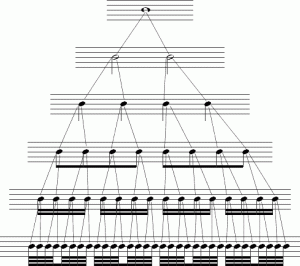What Did I Leave Out?
Students in EDM 310 are required to ask and respond to a question that we formulate. As a music teacher, I believe it is one of my responsibilities to ensure the continuation of fine arts education. Oftentimes, music is the first area to be removed from schools without administrators comprehending the ramifications of the action. My question is:
What ways could one integrate the arts in the general education classroom?
 |
Ruth Catchen, a music educator and advocator of arts in STEM, is currently creating an application called STEAM-mates that will incorporate iPad applications, online tools, and PBL models in the classroom to assist in blending the arts with science and math. Technology will be used as a tool to enhance problem-solving and critical thinking skills while following the guidelines of CCSS. One example Ms. Catchen provides is using music to improve the progress of math skills. She states, "learning notation in music is understanding fractions". A whole note is four beats, half note is two beats, quarter note is one beat, etc. An instructor could use a diagram (such as the photo located to the right) to have a visual for the students, as well as play rhythmic games for a better understanding of fractions.
In the website, Edutopia, several articles were written encouraging the idea of using various art forms in teaching other subject areas. Mariko Nobori's "How the Arts Unlock the Door to Learning" followed Bates Middle School in Maryland and showed the audience how issuing a "bold strategy" (putting arts into curricula) facilitated the improvement and growth of their students. The objective for this approach to teaching was to fuse the arts into core curricula that would produce connections and captivate the students's interests. A lesson plan that an individual could view in a science class required students to dance in order to demonstrate their understanding of the rotation and revolution of planets. An eighth grade math teacher taught a class concerning basic principles of design for photo stories to help students prepare for an exam on linear equations. Mr. Nobori stated that they observed the children to be excited about learning, and some said that using the fine arts helped them retain data. The question "why does it work" is inquired, and the answer is simply established: "Arts integration uses teaching practices that have been shown in brain-based research to improve comprehension and long-term retention."
Susan Riley writes concerning the issues that educators are faced with that decide to incorporate the arts in the classroom. With integration, one must embrace collaboration, intentional alignment, research, and practical application to establish beneficial lesson plans. Ms. Riley says that this "approach to teaching includes intentional identification of naturally aligned standards, taught authentically alongside meaningful assessments which take both content areas to a whole new level." To simply put it, this path is difficult but worthwhile for the students. With art integration, the Common Core State Standards are enhanced and display productivity among teachers and students. Ms. Riley presents a basic outline for instructors who are hesitant regarding this format due to lack of experience in the arts:
- Focus on an arts area that the teacher is comfortable
- Construct a lesson plan that stays true to both integration and CCSS
- Verify that both areas are coordinated equally
- Communicate between general education and arts teachers to align target goals
With schools that encourage arts integration, teachers can surpass expectations defined by CCSS and aid in their students's growth of true inquiry and training for the future.

No comments:
Post a Comment